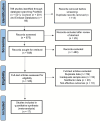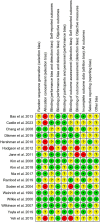Assessment of non-pharmacological nursing strategies for pain management in tumor patients: a systematic review and meta-analysis
- PMID: 40303318
- PMCID: PMC12037582
- DOI: 10.3389/fpain.2025.1447075
Assessment of non-pharmacological nursing strategies for pain management in tumor patients: a systematic review and meta-analysis
Abstract
Summary background: Cancer is a multifactorial disease associated with intense pain and fatigue. Pain is the main discomfort experienced during cancer treatment, particularly as a major side effect of chemotherapy.
Objective: This study has aimed to investigate the effectiveness of non-pharmacological nursing strategies, including reflexology, aromatherapy, acupressure, massage therapy and acupuncture, in the management of cancer-associated pain. Moreover, it provides evidence-based recommendations for integrating these interventions into standard pain management protocols.
Search methodology: We gathered data from three major online databases; PubMed, the Cochrane Library and Embase. For the analysis, we exclusively targeted randomized controlled trials (RCTs) assessing the effectiveness of non-pharmacological interventions in managing cancer-related pain. No language restrictions were applied, and pain was considered the primary outcome measure.
Results: Seventeen RCTs (n = 1,070) were included in this meta-analysis from 166 eligible studies. The pooled effect size demonstrated that all evaluated non-pharmacological nursing strategies, including aromatherapy, massage, reflexology, acupressure and acupuncture significantly reduced cancer-related pain compared to usual care (p < 0.001). Moreover, the reflexology and massage showed negligible heterogeneity among other interventions.
Conclusion: This meta-analysis found the significant effectiveness of non-pharmacological nursing strategies, particularly reflexology and massage in reducing cancer-related pain. The findings support their integration into clinical practice, providing evidence-based recommendations for enhancing standard pain management protocols.
Keywords: acupressure; acupuncture; aromatherapy; cancer-related pain; massage; reflexology.
© 2025 Yan, Yan, Liangyu and Fei.
Conflict of interest statement
The authors declare that the research was conducted in the absence of any commercial or financial relationships that could be construed as potential conflicts of interest.
Figures







Similar articles
-
The effectiveness of aromatherapy, massage and reflexology in people with palliative care needs: A systematic review.Palliat Med. 2020 Feb;34(2):179-194. doi: 10.1177/0269216319884198. Epub 2019 Oct 29. Palliat Med. 2020. PMID: 31659939 Free PMC article.
-
Complementary and alternative therapies for post-caesarean pain.Cochrane Database Syst Rev. 2020 Sep 1;9(9):CD011216. doi: 10.1002/14651858.CD011216.pub2. Cochrane Database Syst Rev. 2020. PMID: 32871021 Free PMC article.
-
The Effects of Aromatherapy Massage and Reflexology on Pain and Fatigue in Patients with Rheumatoid Arthritis: A Randomized Controlled Trial.Pain Manag Nurs. 2016 Apr;17(2):140-9. doi: 10.1016/j.pmn.2016.01.004. Epub 2016 Apr 16. Pain Manag Nurs. 2016. PMID: 27091583 Clinical Trial.
-
Clinical Evidence for Association of Acupuncture and Acupressure With Improved Cancer Pain: A Systematic Review and Meta-Analysis.JAMA Oncol. 2020 Feb 1;6(2):271-278. doi: 10.1001/jamaoncol.2019.5233. JAMA Oncol. 2020. PMID: 31855257 Free PMC article.
-
Aromatherapy massage versus reflexology on female elderly with acute coronary syndrome.Nurs Crit Care. 2018 Sep;23(5):229-236. doi: 10.1111/nicc.12302. Epub 2017 Jun 2. Nurs Crit Care. 2018. PMID: 28573820 Clinical Trial.
References
Publication types
LinkOut - more resources
Full Text Sources

